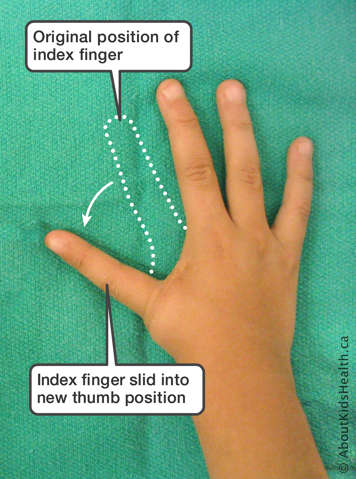
Some children are born without a thumb or with an underdeveloped thumb that does not work. In some cases, surgeons can reposition the index finger to make it work like a thumb. This surgical procedure is called pollicization.
Your surgeon will discuss this surgical option with you and determine whether your child is a good candidate. A child who is consistently trying to use their index finger like a thumb is usually a good candidate.
At what age is the procedure done?
Surgeons do not perform pollicization at a specific age. In fact, doctors will likely ask you to wait and see how your child uses their fingers and thumb to grasp and hold objects. This helps them decide whether pollicization is the best option for your child.
Newborns
Although many parents want to do something as soon as possible, newborns are too young to find their preferred grasp patterns and too tiny for complex surgery.
Toddlers
A good age to consider pollicization is when your child is a toddler. Toddlers are naturally exploring their hand skills and can easily grasp patterns. This makes therapy after surgery easier. Also, post-operative therapy is minimal since toddlers tend to do their own therapy through play!
Teens
Children, who did not have pollicization done at a young age, sometimes decide as teens they would like this surgery. Although surgery can be done during this age, it is a bit more challenging because we become more prone to stiffness as we age.
What happens during the procedure?
After removing the thumb, the surgeons shorten one of the bones in the index finger. They then slide the shortened index finger (including all its tendons and nerves) into the thumb position. The index finger is NOT amputated and replanted. It remains attached at all times. Your child will be under general anaesthesia during the surgery.
After surgery
What does the new thumb look like?
After the procedure, your child will have a scar at the base of the new thumb. The surgeons shorten and position the finger so that it looks as much like a thumb as possible. Many times, people have to do a double take: they count the fingers to convince themselves there is one missing.
How long would my child be in hospital?
Usually, your child stays in hospital for one night after the surgery. If your child is feeling well the next day, you will be able to go home.
After surgery, your child may need to wear a splint to protect the new thumb. Your surgeon and occupational therapist will discuss this with you in more detail.
Does the thumb actually work?
The new thumb will always be thinner than a typical thumb. But it will be the right length and in the right position. Best of all, it will work like a thumb.
Before surgery: your child can only pick up objects using the space between their fingers.
After surgery: Your child will be able to grasp small and large objects.

Will my child need therapy?
Yes. The occupational therapist teaches your child stretches and activities so they can use their new thumb to its full potential. They suggest activities you can do at home as well.
The occupational therapist monitors your child's progress every few weeks. They will do this either at the hospital or a location closer to your home.
How long will it take to heal?
After about four weeks, the bones start to heal and your therapist will help your child move the thumb.
Over the next eight weeks, your child will progress from using their thumb with light resistance to full range of motion and full resistance. There will likely be redness and slightly raised scarring at the base of the thumb, which will take several months to heal.
About 12 weeks after surgery, your child's thumb should be fully functional. Your child will be able to use their thumb on their own and no longer need to continue with therapy. The scars may still appear red and raised. Continue massaging the scars with Vaseline.
For more information, please see Congenital hand anomaly (hand difference).